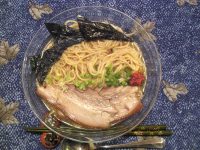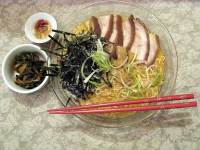This blog is about Japanese home cooking and and while many of the recipes are unfamiliar, my repertoire is growing enough to allow some coordination of make-ahead foods that can be served in combinations that don’t seem as if we are eating leftovers every other day. For example, I grilled Chicken in Spicy Marinade at the same time as the Yakitori: Negima was cooking. We first ate the marinated chicken with Stir-Fried Fennel and Carrot. Then we had two different versions of today’s recipe with the chicken.
 These ramen noodles are very popular in Japan, but apparently they are served only in the summer. Below is the recipe as written in my project book, but Ms. Shimbo has many suggestions for different toppings. Note that she says this dish always includes the thin omelette strips.
These ramen noodles are very popular in Japan, but apparently they are served only in the summer. Below is the recipe as written in my project book, but Ms. Shimbo has many suggestions for different toppings. Note that she says this dish always includes the thin omelette strips. You can use seafood (crab meat, shrimp, or squid), meat (chashu, ham, chicken) and a variety of vegetables (asparagus, bell peppers, broccoli, carrot, chard, cucumber, fennel, lettuce, spinach, wakame, zucchini…).
You can use seafood (crab meat, shrimp, or squid), meat (chashu, ham, chicken) and a variety of vegetables (asparagus, bell peppers, broccoli, carrot, chard, cucumber, fennel, lettuce, spinach, wakame, zucchini…).
 Because of all the variations, this recipe is another example of home-cooking multi-tasking. I doubled the sauce recipe, so it’s ready to go and I can concentrate on a new recipe to accompany the noodles.
Because of all the variations, this recipe is another example of home-cooking multi-tasking. I doubled the sauce recipe, so it’s ready to go and I can concentrate on a new recipe to accompany the noodles.
While I could eat noodles everyday, Mr. Tess will be happy, too, because there are lots of vegetables!
Summertime Chilled Chuka Soba
Hiyashi Chukasoba
serves 4
page 346
Sauce:
- 1/4 cup mirin (sweet cooking wine)
- 1 Tablespoon sugar
- 1 1/3 cup ramen stock or chicken stock
Note: my homemade stock is gelatin, so I just used canned chicken broth. - 1/3 cup shoyu (soy sauce)
- 2 1/2 Tablespoons komezu (rice vinegar)
- 1 Tablespoon sesame oil
- 2 teaspoons ginger juice, to taste Here’s a tip extracting juice
In a saucepan, bring the mirin to a gentle simmer to evaporate the alcohol. Add sugar and ramen stock, and bring to a boil. Add the soy sauce and bring just to a boil. Transfer to a clean jar. Add the rice vinegar, sesame oil, and ginger juice. Refrigerate for 2 to 3 hours.
Thin Omelettes:
- pinch of salt
- 1 teaspoon sugar
- 4 eggs, lightly beaten
- 1 1/2 Tablespoons vegetable oil (I used much less)
Stir the salt and sugar into the eggs. Note stirring with a chopstick works well because you don’t want to make the eggs frothy.
If you have a tamagoyaki-ki, a rectangular Japanese skillet, now is your chance to make use of it! Otherwise, use an 8-inch non-stick skillet or a well seasoned cast iron pan. Heat your skillet over medium heat. When it’s hot, dip a wadded paper towel into a small dish of vegetable oil. Smear the bottom and sides of your skillet with the oil. Remove skillet from heat and spoon enough of the egg mixture to thinly coat the bottom of your pan. You may need to tilt the pan to cover the whole bottom. Return the skillet to the heat and cook the egg until it’s firm on the bottom. Lift the omelette and flip to cook the other side, about 3 seconds. Remove to a paper towel lined plate. Make 8 thin omelettes. Cut the omelettes into 2-inch long julienne strips.
The Vegetables:
- 3 cups soybean or mung bean sprouts
- 2 ounces mung bean noodles
- 1 small Japanese cucumber, julienned in 2 1/2-inch lengths
- 8 cherry tomatoes, cut in half
- 10 slices chashu, or cooked ham or chicken breast, julienned in 2-inch lengths
If you can get soybean sprouts, try them: they are delicious. Clean the sprouts by cutting off the brown root tips. In a pot of boiling water (add a little vegetable oil), blanch the sprouts for 30 seconds. Immediately drain and rinse in cold water. Drain again.
Soak the mung bean noodles in boiled water for 5 minutes. Drain and cool under running water. Cut into 6-inch lengths. (or follow package directions)
The Noodles:
- 13 ounces dried chuasoba noodles
- 2 teaspoons sesame oil
In a large pot of boiling water, cook the noodles al dente, 3 to 5 minutes, or as instructed on the package. Drain and wash under cold running water. Drain and toss with the sesame oil.
Garnishes:
- 2 Tablespoons white sesame seeds, toasted
- Hot mustard paste or smooth French-style mustard
Divide the noodles among four individual sh
allow bowl. Decorate the noodles with the vegetables and omelette strips. In the traditional presentation, the items are placed in mounds like the colorful spokes of a wheel. Pour some of the sauce over each dish, and garnish with some sesame seeds on top and a dab of mustard on the rim of the bowl.
(The way I actually served this meal was to arrange the vegetables and meat on a large plate, the noodles in a bowl, the garnishes on the side, and the sauce in a jar ready to pour over. We each served ourselves.)
More in this series about ramen:
Ramen Stock:

Ramen Toppings:



| ⇐ Previous Post | Next Post ⇒ | |
| Spicy Stir-Fried Fennel and Carrots | Tofu Omelette with Colorful Vegetables |











Yum! I used to eat hiyashi chuka a lot when I was younger and with my Japanese boyfriend. It’s such a great dish for summer! Tess, it must be heaven for your friends and family to have you in the kitchen experimenting all the time…
I love hiyashi chuka! How could I have missed this recipe last summer?
That’s looks yummy!
I cooked “Hiyashi chuka” recently as well!
Welcome Kumiko!
Your “hiyashi chuka” also looks yummy!
looks like a wonderful summer dish!
Hello SteamyKitchen!
So sorry to take so long to welcome you—somehow, I missed your comment. This has to be my favorite recipe of the month.
Pingback: User links about "ramen" on iLinkShare
Wow, you have so many recipes on Hiuashi Chuka, lovely to know different variations. Thanks for letting me know, have to come back to try one of your dressing next time.
Pingback: Summer Noodles: Hiyashi Chuka Soba « Tess’s Japanese Kitchen
I’m trying to find and purchase “Chuka Soba Noodles”.
Web sites make many references to “Soba” Noodles but only a few to “Chuka” Soba noodles. Can you please tell me if there is a difference, and what that difference is?
Hi Robert Hess,
Chuka refers to “Chinese.” And soba, in this special case, means noodles. Chukasoba can be straight or curly. They are, in my experience, always thin.
Soba noodles are thin straight brownish noodles made with buckwheat flour.
Chuka soba are ramen noodles, and they are made with wheat flour and water mixed with an alkaline agent: sodium carbonate or potassium carbonate. The natural form of the alkaline agent is called kansui, but I’ve never seen that listed on the ingredients so I’m guessing it is expensive and rare.
There are some references I’ve found online that say egg (yolk?) will also act as alkaline, but I don’t know—I have made egg noodles and they are not the same. Note, though that I’ve tried some thin curly noodles made in China and the ingredient list includes egg.
Here is a picture of one brand of dried chuka soba noodles I buy. These are usually less than $2, but easy to find. More difficult to find, and more expensive, are curly noodles from Shirakiku (imported from Japan).

You can also find chuka soba in Japanese groceries sold as ramen noodles, frozen or dried. They come with a packet of soup-base, which I throw away. Don’t buy the instant ramen, unless it is the only choice. Instant ramen are oily and have been pre-cooked.
To confuse things even more, there are also yakisoba. I believe they are chukasoba noodles which have been steamed (at any rate, they are wheat noodles which have been steamed), and are sold soft, in the refrigerated section.) Yakisoba are stir-fried with vegetables and eaten as a snack at festivals.
Here is a picture of soba noodles:

There is no confusion when you see them!
I followed your directions and the dish turned out excellent. I figured winter in southern California is like summer in many parts of the world. I lived in Japan for a year and I loved the Ramen-ya’s (Noodle Shops). For some reason I craved it today googled “chuka soba” and found your blog. Thanks for the help.
Thank you for your comment! I’m happy to know that you liked this recipe: “The Japanese Kitchen” (Hiroko Shimbo). That’s the book I’ve been studying, and excellent recipes she has!
Southern CA! you lucky dog!
LOL, I’m in Michigan and weather predictions were for warmer temperatures. So I wore a (thin) short-sleeved tee-shirt to work. Gotta say, mid to upper 30’s is not a great time to do that…
Summer is a distant memory or a hoped for state of being.
best regards!
Tess